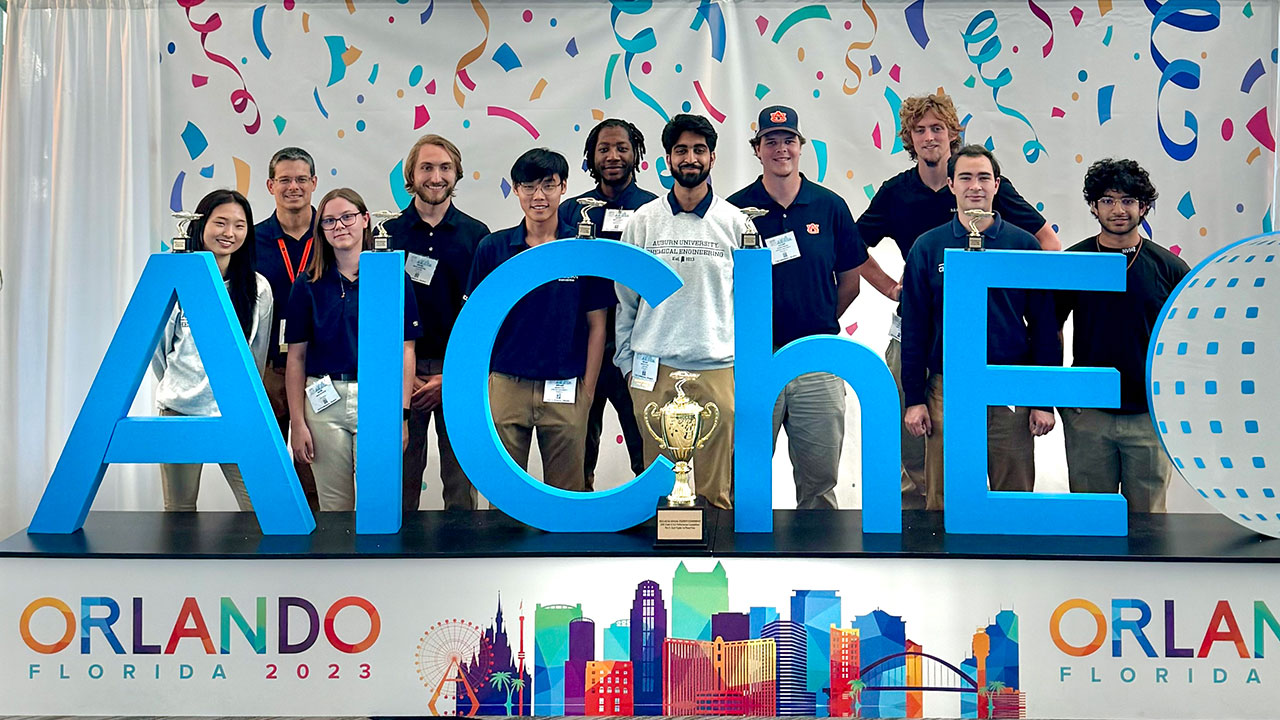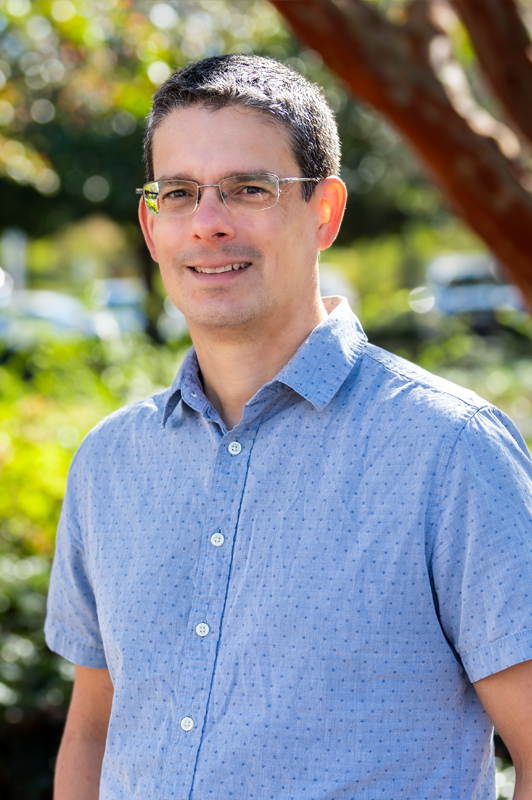Chemical engineering student team wins international AIChE Chem-E car championship
Published: Dec 7, 2023 8:00 AM
By Joe McAdory
What travels 1.39 mph, is chemically powered by a lead-acid battery and can stop within a meter of its desired target? Auburn University’s award-winning, 20cm x 30cm x 40cm Chem-E car.
Auburn’s 25-student Chem-E Car Team captured the international championship Nov. 5 at the annual American Institute of Chemical Engineers (AIChE) Student Conference in Orlando, Florida. This victory comes after consistently placing in the top three at regional AIChE competitions and seventh last year in the international AIChE finals in Phoenix, Arizona.
“Our team’s record speaks to Auburn’s culture,” said Ishan Patel, a senior and team captain. “My teammates and I spent many late nights, with some members putting anywhere close to 30 to 40 weeks of additional time outside of meetings. This type of dedication is what originally brought students to chemical engineering at Auburn and the curriculum’s rigor shows the brute stamina and determination my fellow teammates have.”
Jeffrey Rice, senior lecturer in the Department of Chemical Engineering and Chem-E car faculty advisor, said the international championship was not solely from this year’s students, but also from previous generation of students who passed down their knowledge and leadership abilities.
“This also shows Auburn University’s ability to continuously recruit talented, hard-working students and the chemical engineering department’s ability to guide and provide for them to succeed,” he said. “They did an amazing job and should be proud that their hard work and dedication paid off.
“Our hard-working students embody the Auburn Creed. The Chemical Engineering Alumni Council visits our department every semester and meets with each class. When they visit students in my class, they always stress the importance of teamwork and being a responsible group member for successful careers. The Auburn University Chem-E Car Team provides ample opportunities for students to work together as a highly functioning team and develop these skills.”
Team members included Ishan Patel (captain), David Swafford (design lead), Minjae Jung (stopping lead), Logan Phillips (power lead), Jerin Thomas (safety lead), Katie Wolfe (design team), Matthew Do (design team), Saim Siddiqui (design team), Benjamin Gunasekaran (design team), Ian Wilkinson (design team), Arthur McPherson (design team), Parker Green (design team), Brent Russell (design team), Emma Kim (stopping team), Greydon Franck (stopping team), Andrew Arnold (power team), Hudson Hargrave (power team), Stephen Marble (power team), Cole McCollough (power team), and other team members Abigail Cain, Debora Vasconcelos, Oscar Earhart, Russell Hegar, and Zachary Bradford.
The 46-team competition wasn’t about which automated car sped fastest to the finish line. Instead, whose car stopped closest to the finish line. Auburn’s car completed the 25-meter distance less than .062 meters from the stripe, compared to .112 meters by runner-up Institut Teknologi Sepuluh Nopember of Indonesia.
“In our preparation, our team ensured the car could stop anywhere between 15 meters to 30 meters within a two-minute restriction as that is the range of the competition,” Patel said. “Because there is no driver, the car goes and stops by itself using only chemicals – motor-driven by a lead-acid battery and stopped via an iodine-clock reaction.”
How does it work? When the car is turned on, its motor takes energy from a lead-acid battery, causing the wheels to turn. Due to the constant voltage of the battery, the car moves roughly about 0.32 meters per second. Inside, an iodine-clock reaction occurs alongside a light sensor. Once the reaction is complete, the solution, read by the light sensor, quickly morphs from clear to dark. Light is no longer recognized, halting the motor.
Jung, the team’s stopping lead, said competitions such as these require teamwork, improves time management and thrusts student designers into stressful situations, thus, sharpening skills.
“It might be funny saying that putting chemicals into cars is stressful,” he said. “However, during competition, the entire team’s success depended on the stopping team to ensure the car stopped at the right time and distance. Being part of that experience, meeting new people and learning about their experiences is what allows these competitions to make better engineers.
“One part of the team cannot succeed without the other’s help and I am really thankful for the time and effort each team member put into this car and am proud we were able to bring home a first-place trophy, especially since this was my last competition. This win can’t fully explain the high standards for the chemical engineering curriculum that Auburn provides. However, it encompasses the Auburn Creed, from hard work to honesty and camaraderie. This speaks on the dedication and commitment that Auburn chemical engineering students have.”
Patel, who joined the Chem-E car team as a freshman in 2019, agreed.
“When I was a freshman, the team leads and captains were all graduating seniors then,” he said. “They mentored me and gave me useful advice on navigating college and chemical engineering. Looking back, I have passed a similar tradition as a soon-to-be graduating senior giving similar advice and mentorship to the freshmen joining the team now. Seeking and giving mentorship is a useful trait in any field as any engineer can tell you that, as well as anyone in academia.”
Media Contact: , jem0040@auburn.edu, 334.844.3447
Auburn Chem-E car team members competing in Orlando were, from left, Emma Kim (stopping team), Jeffrey Rice (faculty advisor), Katie Wolfe (design team), David Swafford (design team lead), Minjae Jung (stopping team lead), Jerin Thomas (safety lead), Ishan Patel (captain), Logan Phillips (power team lead), Greydon Franck (stopping team), Drew Arnold (power team), Saim Siddiqui (design team).


